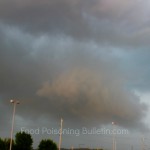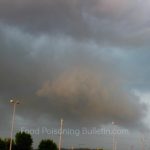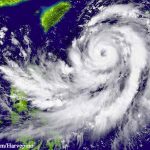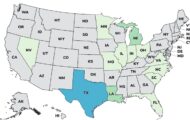The USDA's Food Safety and Inspection Service (FSIS) is issuing food safety recommendations for the Northeast, Central Appalachians and Ohio Valley because of severe thunderstorms. These storms may cause power outages that could compromise the safety of food in consumers' homes. If the power goes out, keep appliance thermometers in the refrigerator and freezer. Safe temperatures are 40°F or lower in the refrigerator and 0°F or lower in the freezer. Freeze water in 1-quart containers before the storm to help keep food cold. They can be put around the food in both appliances to keep food cold. Freeze leftovers, milk, and fresh meat and poultry before the storm to keep them at a safe temperature longer. Know where you can get block or dry ice to help keep food cold. Fifty pounds of dry … [Read more...]
USDA Food Safety Tips for Winter Weather Emergencies
The U.S. Department of Agriculture’s (USDA) Food Safety and Inspection Service (FSIS) has compiled some food safety tips for those affected by severe winter weather in the northern Rockies and upper Great Lakes. Heavy snowfalls in Montana, the Dakotas, Minnesota, Wisconsin and Michigan could cause power outages posing which create food safety risks. FSIS recommends consumers follow these steps to reduce food waste and the risk of foodborne illness during severe weather events. Print this information and put it on your pantry door for future reference. Before the storm, purchase appliance thermometers for the refrigerator and the freezer, freeze refrigerated items, such as leftovers, milk and fresh meat and poultry that you may not need immediately. Group foods together in the … [Read more...]
USDA Food Safety Tips for Hawaiians in the Path of Tropical Storms
The U.S. Department of Agriculture’s (USDA) Food Safety and Inspection Service (FSIS) has compiled some food safety recommendations for those in Hawaii experiencing severe weather related to Tropical Storms Iselle and Julio. The storms are expected to reach the Hawaiian Islands on Thursday into Friday. Here's what the agency recommends. If you don't have an appliance thermometer for your fridge and freezer go buy them. Locate your coolers, clean them out. If you don't have one and have perishable food you want to save, buy one. Buy some ice and store it in the cooler. Buy a few days worth supply of fresh water and food that does not need to be refrigerated or cooked. Group meat and poultry one side of the freezer preferably on a tray to prevent cross contamination from thawing thawing … [Read more...]
Food Safety Tips for Hurricane Arthur Victims
The USDA is offering food safety recommendations for those affected by Hurricane Arthur. If you lose power, food could spoil and pathogenic bacteria can grow. Keep appliance thermometers in the fridge and freezer. Safe temperatures are 40°F in the refrigerator and 0°F in the freezer. Freeze water in one-quart plastic storage bags or containers before a storm. Water expands when it freezes, so don't overfill. Freeze refrigerated items, such as leftovers, milk, and fresh meat and poultry to keep them at a safe temperature longer. Know where you can get block or dry ice. Fifty pounds of dry ice will keep an 18-cubic-food freezer cold for two days. Have coolers on hand to keep refrigerated food cold if the power is out for more than four hours. Group foods together in the freezer for an … [Read more...]
USDA Tips for Florida and Alabama Residents Affected by Flooding
The USDA has issued food safety recommendations for citizen affected by a massive storm system that caused severe flooding in the Florida Panhandle and the Alabama Coast. More than 10 inches of rain was dropped by that weather system. Pensacola saw between 15 and 20 inches of rain in 24 hours as of Wednesday, April 30, 0214. The flooding is the worst that area has seen in 30 years. As many as 30,000 residents are without power. More rain and wind are expected, and flash flooding is going to be a reality across most of the eastern U.S. from southern New England to the Gulf Coast. Food that has been in a flood needs to be inspected carefully. Unless the food is canned or sealed commercially and the container can be washed in a bleach solution or boiled, it must be discarded. Any food … [Read more...]
USDA’s Food Safety Tips For Severe Weather
The U.S. Department of Agriculture (USDA) has compiled some food safety tips for residents in the South and Midwest affected by severe weather. Here's what you need to know about food safety when sever weather is in the forecast. Before the storm strikes, make sure you have working appliance thermometers in both the refrigerator and the freezer. Safe temperatures for the fridge are 40°F or lower, in the freezer 0°F or lower. Freeze water in one-quart plastic storage bags or other small containers prior to a storm. Tuck them in between frozen foods to help keep them cold. Freeze any food you don't plan to eat in the immediate future such as leftovers, milk, fresh or poultry. This will help to keep them at a safe temperature for a longer period of time. Group food together in the freezer … [Read more...]
USDA Offers Food Safety Tips for Snow Storms
Snow storms are affecting large parts of the country in the Great Plains, Midwest, and Northeast. The USDA is offering food safety recommendations for those affected by the weather. Power outages that result from weather emergencies can compromise the safety of stored food. FSIS has several videos for you to watch about this issue. And the government provides food safety information from its Twitter feed as the storms progress. To keep your food safe in the storm, always keep appliance thermometers in the fridge and freezer. The safe temperatures are below 40°F in the fridge, and 0°F in the freezer. Freeze water in one-quart plastic storage bags or containers before the storm. Use these to keep food in the fridge and freezer cold. Know where you can get block or dry ice, and have … [Read more...]
Preparing for Emergencies During Winter Weather
Much of the U.S. is facing severe winter weather this weekend. A snowstorm in the Northeast and record-breaking cold in the Midwest could cause power outages. To keep your food safe, follow these tips. Keep an appliance thermometer in your refrigerator and freezer. In case of a power outage, you can tell if the appliance an keep food safe. Freezers should be at 0°F and refrigerators at 40°F or lower. Freeze containers or water ahead of time to use to keep the fridge and freezer cold. But don't put food out in the snow to freeze. Outside temperatures can vary too much, and animals might get to the food and eat it or contaminate it. Instead, use the cold temps to make ice. Fill buckets, empty milk containers, and cans with water and let them freeze. Use this ice to keep the fridge and … [Read more...]
Food Safety Tips for Severe Weather
The USDA is offering food safety tips for those affected by severe storms. Power outages from weather emergencies can cause food safety problems. The agency is also offering a video broadcast on this topic you can watch. FSIS also provides food safety information as storms progress from its Twitter feed @USDAFoodSafety. Before the storm, make sure you have appliance thermometers in your fridge and freezer. Safe temperatures are 40 degrees F or lower in the refrigerator, and 0 degrees F or lower in the freezer. Freeze water in one quart containers before the storm. This will ensure you have fresh water available, and the frozen containers can be used to help keep food in your fridge safe. Freeze leftovers and other items before the storm, since the freezer will keep food safer longer … [Read more...]
Tips for Handling Food After Power Outage
The Minnesota Department of Agriculture and Department of Health has issued tips for safe food handling after the recent power outages that affected more than 500,000 households over the weekend. Some consumers have had no power for four days; many will not get their power back until June 26, 2013. Food that loses refrigeration for more than four hours can be a risk for foodborne illness. While the power is out, keep the refrigerator door closed to keep cold air inside the appliance. Discard any perishable food that has been at temperatures above 40 degrees F for more than two hours. A full freezer can keep food cold and safe for about 48 hours (24 hours if half-full). Dry or block ice can be used to keep a fully stocked 18-cubic-foot freezer cold for two days. For food safety, it's … [Read more...]










